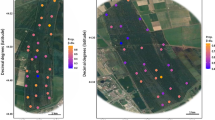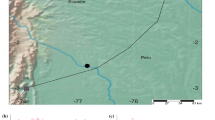Abstract
Understanding the conditions under which species traits, species–environment relationships, and the spatial structure of the landscape interact to shape local communities requires quantifying the relative contributions of space and the environment on community composition. Using analogous sampling of arboreal and terrestrial oribatid mite communities across a large spatial scale in a temperate rainforest, we quantified the variation in oribatid mite community structure relating to environmental and spatial factors, and tested whether terrestrial and arboreal communities demonstrated a difference in their patterns of community composition based on the assumption of differences in dispersal potential. The expectation that terrestrial oribatid mite communities are spatially structured while arboreal communities are environmentally structured was supported by our analyses at the level of variation in beta diversity, but not by assessing beta diversity itself. We found that terrestrial oribatid mite communities with active, cursorial dispersal demonstrate spatial constraint consistent with reduced long-distance dispersal opportunities and high environmental dissimilarity among sites. Arboreal communities, which potentially disperse long distances via passive aerial vectors, show a spatial signature associated with patterns in beta diversity and a correlation with environmental dissimilarities among sites. In the arboreal community, moisture content of the substrate, total tree height, and average sampled branch height were significant factors explaining beta diversity patterns. For ground-dwelling species, predator abundance and soil type were important local determinants of community variability. Both communities showed clear spatial structuring, suggesting that dispersal limitation continues to influence community composition across multiple forest watershed locations. Our results provide evidence of dispersal-maintained diversity patterns in response to local environmental factors in arboreal and terrestrial communities. The relative importance of stochastic dispersal assembly may be dependent on strong deterministic effects associated with micro-site and macro-site environmental variation, particularly across large spatial scales.




Similar content being viewed by others
References
Anderson JM (1978) Inter- and intra-habitat relationships between woodland Cryptostigmata species diversity and the diversity of soil and litter microhabitats. Oecologia 32:341–348
Behan-Pelletier VM, Walter DE (2000) Biodiversity of oribatid mites (Acari: Oribatida) in tree canopies and litter. In: Coleman DC, Hendrix PF (eds) Invertebrates as webmasters in ecosystems. CAB International, Wallingford, pp 187–202
Behan-Pelletier VM, Winchester NN (1998) Arboreal oribatid mite diversity: colonizing the canopy. Appl Soil Ecol 9:45–51
Berthet PL (1964) Field study of the mobility of Oribatei (Acari), using radioactive tagging. J Anim Ecol 33:443–449
Bonnet E, Van de Peer Y (2002) ZT: a software tool for simple and partial Mantel tests. J Stat Softw 7:1–12
Borcard D, Legendre P (2002) All-scale spatial analysis of ecological data by means of principal coordinates of neighbour matrices. Ecol Modell 153:51–68
Borcard D, Legendre P, Drapeau P (1992) Partialling out the spatial component of ecological variation. Ecology 73:1045–1055
Brown JH, Kodric-Brown A (1977) Turnover rates in insular biogeography: effect of immigration on extinction. Ecology 58:445–449
Chase JM (2007) Drought mediates the importance of stochastic community assembly. Proc Natl Acad Sci USA 104:17430–17434
Clark JS (1998) Why trees migrate so fast: confronting theory with dispersal biology and the paleorecord. Am Nat 152:204–224
Cottenie K (2005) Integrating environmental and spatial processes in ecological community dynamics. Ecol Lett 8:1175–1182
Cottenie K, Michels E, Nuytten N, De Meester L (2003) Zooplankton metacommunity structure: regional vs. local processes in highly interconnected ponds. Ecology 84:991–1000
Crist TO, Veech JA, Gering JC, Summerville KS (2003) Partitioning species diversity across landscapes and regions: a hierarchical analysis of α, β, and γ diversity. Am Nat 162:734–743
Dray S, Legendre P, Peres-Neto PR (2006) Spatial modelling: a comprehensive framework for principal coordinate analysis of neighbour matrices (PCNM). Ecol Modell 196:483–493
Fagan LL, Didham RK, Winchester NN, Behan-Pelletier V, Clayton M, Lindquist E, Ring RA (2006) An experimental assessment of biodiversity and species turnover in terrestrial vs canopy leaf litter. Oecologia 147:335–347
Flinn KM (2007) Microsite-limited recruitment controls fern colonization of post-agricultural forests. Ecology 88:3103–3114
Griffin DW, Kellogg CA, Garrison VH, Shinn EA (2002) The global transport of dust: an intercontinental river of dust, microorganisms and toxic chemicals flows through the earth’s atmosphere. Am Sci 90:228–236
Jones MM, Tuomisto H, Borcard D, Legendre P, Clark DB, Olivas PC (2008) Explaining variation in tropical plant community composition: influence of environmental and spatial data quality. Oecologia 155:593–604
Jung C, Croft BA (2001) Aerial dispersal of phytoseiid mites (Acari: Phytoseiidae): estimating falling speed and dispersal distance of adult females. Oikos 94:182–190
Karasawa S, Gotoh K, Sasaki T, Hijii N (2005) Wind-based dispersal of oribatid mites (Acari: Oribatida) in a subtropical forest in Japan. J Acarol Soc Jpn 14:117–122
Klinka K, Green RN, Trowbridge RL, Lowe LE (1981) Taxonomic classification of humus forms in ecosystems of British Columbia—first approximation (Land Management Report No. 8). Ministry of Forests, Victoria, BC
Krivolutsky DA, Lebedeva NV (2004) Oribatid mites (Oribatei, Acariformes) in bird feathers: non-passerines. Acta Zool Litu 14(1):26–47
Legendre P, Gallagher ED (2001) Ecologically meaningful transformations for ordination of species data. Oecologia 129:271–280
Legendre P, Borcard D, Peres-Neto PR (2005) Analyzing beta diversity: partitioning the spatial variation of community compositional data. Ecol Monogr 75:435–450
Legendre P, Borcard D, Peres-Neto PR (2008) Analyzing or explaining beta diversity: comment. Ecology 89:3232–3237
Leibold MA, Holyoak M, Mouquet M, Amarasekare P, Chase JM, Hoopes MF, Holt RD, Shurin JB, Law R, Tilman D, Loreau M, Gonzalez A (2004) The metacommunity concept: a framework for multi-scale community ecology. Ecol Lett 7:601–613
Lindo Z (2008) Community structure of oribatid mites associated with arboreal and terrestrial habitats (Ph.D. dissertation). The University of Victoria, Canada
Lindo Z, Winchester NN (2007a) Resident corticolous oribatid mites (Acari: Oribatida): decay in community similarity with vertical distance from the ground. Écoscience 14:223–229
Lindo Z, Winchester NN (2007b) Local–regional boundary shifts in oribatid mite (Acari: Oribatida) communities: species–area relationships in arboreal habitat islands of a coastal temperate rainforest, Vancouver Island, Canada. J Biogeogr 34:1611–1621
Lindo Z, Winchester NN (2008) Scale dependent patterns in arboreal and terrestrial oribatid mite (Acari: Oribatida) communities. Ecography 31:53–60
Lindo Z, Winchester NN, Didham RK (2008) Nested patterns of community assembly in the colonisation of artificial canopy habitats by oribatid mites. Oikos 117:1856–1864
Mitchell R (1970) An analysis of dispersal in mites. Am Nat 104:425–431
Nadkarni NM, Longino J (1990) Macroinvertebrate communities in canopy and forest floor organic matter in a montane cloud forest, Costa Rica. Biotropica 22:286–289
Nekola JC, White PS (1999) The distance decay of similarity in biogeography and ecology. J Biogeogr 26:867–878
Noda T (2004) Spatial hierarchical approach in community ecology: a way beyond high context-dependency and low predictability in local phenomena. Popul Ecol 46:105–117
Norton RA (1980) Observations on phoresy by oribatid mites (Acrai: Oribatei). Int J Acarol 6:121–130
Ojala R, Huhta V (2001) Dispersal of microarthropods in forest soils. Pedobiologia 45:443–450
Ozanne CMP, Anhuf D, Boulter SL, Keller M, Kitching RL, Körner C, Meinzer FC, Mitchell AW, Nakashizuka T, Silva Dias PL, Stork NE, Wright SJ, Yoshimura M (2003) Biodiversity meets the atmosphere: a global view of forest canopies. Science 301:183–186
Primer-E Ltd. (2001) Primer 5 for Windows, v.5.2.2. Primer-E Ltd., Ivybridge
Siepel H (1996) The importance of unpredictable and short-term environmental extremes for biodiversity in oribatid mites. Biodivers Lett 3:26–34
Soininen J, McDonald R, Hillebrand H (2007a) The distance decay of similarity in ecological communities. Ecography 30:3–12
Soininen J, Kokocinski M, Estlander S, Kotanen J, Heino J (2007b) Neutrality, niches, and determinants of plankton metacommunity structure across boreal wetland ponds. Écoscience 14:146–154
StatSoft Inc. (2004) Statistica (data analysis software system), v.7. StatSoft Inc., Tulsa, OK (see http://www.statsoft.com)
Steinitz O, Heller J, Tsoar A, Rotem D, Kadmon R (2006) Environment, dispersal and patterns of species similarity. J Biogeogr 33:1044–1054
ter Braak CJF, Smilauer P (1998) Canoco reference manual and user’s guide to Canoco for Windows: software for canonical community ordination, v.4. Microcomputer Power, Ithaca, NY
Tuomisto H, Ruokolainen K (2006) Analysing or explaining beta diversity? Understanding the targets of different methods of analysis. Ecology 87:2697–2708
Tuomisto H, Ruokolainen K, Yli-Halla M (2003) Dispersal, environment, and floristic variation of western Amazonian forests. Science 299:241–244
Van de Meutter F, De Meester L, Stoks R (2007) Metacommunity structure of pond macroinvertebrates: effects of dispersal mode and generation time. Ecology 88:1687–1695
Van der Gucht K, Cottenie K, Muylaert K, Vloemans N, Cousin S, Declerck S, Jeppesen E, Conde-Porcuna J-M, Schwenk K, Zwart G, Degans H, Vyverman W, De Meester L (2007) The power of species sorting: local factors drive bacterial community composition over a wide range of spatial scales. Proc Natl Acad Sci USA 104:20404–20409
Vanschoenwinkel B, De Vries C, Seaman M, Brendonck L (2007) The role of metacommunity processes in shaping invertebrate rock pool communities along a dispersal gradient. Oikos 116:1255–1266
Veech JA, Crist TO (2007) Partition: software for the hierarchical additive partitioning of species diversity, v.2. http://www.users.muohio.edu/cristto/partition.htm, accessed 15 Sept 2008
Acknowledgments
The authors gratefully acknowledge the contributions of Kevin Jordan (Arbornaut Access), for his expertise in canopy sampling, and Alana Jung and Dave Hurwicz, for their help in the field. We especially thank Katie Flinn and Raphael Didham for comments on previous drafts of this manuscript. This research is funded by a grant to ZL (332720-06) and NNW (238631-06) from the Natural Sciences and Engineering Research Council of Canada. The research contained within this manuscript complies with the current laws of Canada.
Author information
Authors and Affiliations
Corresponding author
Additional information
Communicated by Volkmar Wolters.
Electronic supplementary material
Below is the link to the electronic supplementary material.
Rights and permissions
About this article
Cite this article
Lindo, Z., Winchester, N.N. Spatial and environmental factors contributing to patterns in arboreal and terrestrial oribatid mite diversity across spatial scales. Oecologia 160, 817–825 (2009). https://doi.org/10.1007/s00442-009-1348-3
Received:
Accepted:
Published:
Issue Date:
DOI: https://doi.org/10.1007/s00442-009-1348-3




